DOG DAYS AND DRIVEN PHEASANT
Story & Pictures by
Jon Spencer
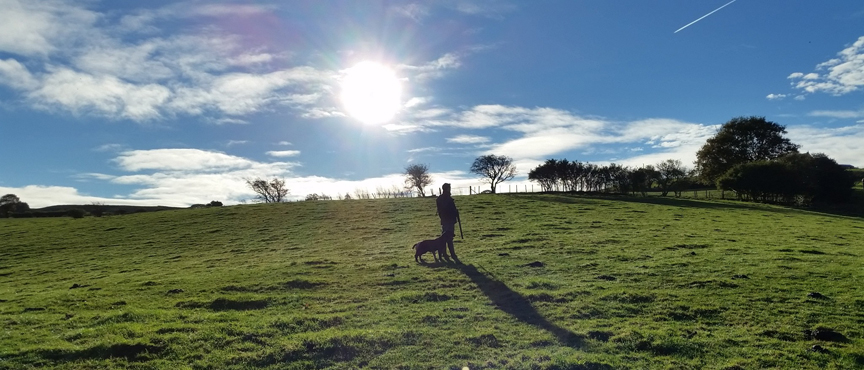
Yesterday, 29th October, was the first day's shooting for many whose primary quarry is pheasant. Legally, they can be shot from 1st October, but as most birds are rear & release types they aren't fully grown or ready until the start of November.
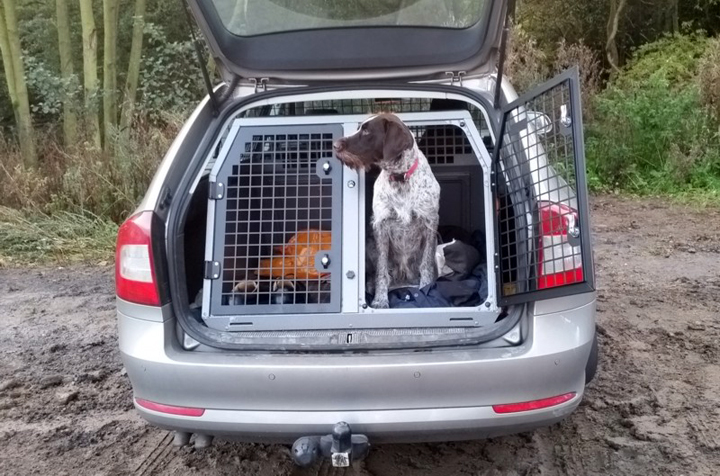 And so the Birk Brow Shoot held their first day yesterday. I took my 18-month old GWP 'Pepper', not intending to work her but simply to let her see what the 'big dogs' get up to. In the event I was used as a spare beater and I did work her and she worked pretty well. She didn't do any retrieving and that was intentional.
And so the Birk Brow Shoot held their first day yesterday. I took my 18-month old GWP 'Pepper', not intending to work her but simply to let her see what the 'big dogs' get up to. In the event I was used as a spare beater and I did work her and she worked pretty well. She didn't do any retrieving and that was intentional.
The Guns and regular Beaters had gone to a local hostelry for a cooked breakfast, not something we do much in this country. I went directly to the farm and was early. I left my 8 year old GWP 'Biggles' at home, as handling two headstrong dogs would be a bit much and the objective was training for Pepper. Here she is eyeing up the farm yard area upon arrival.
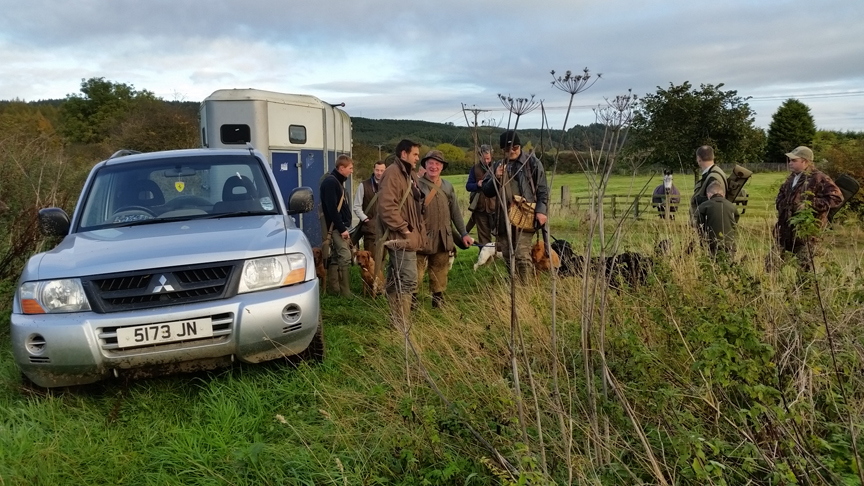
The Guns and Beaters arrived and greeting were exchanged, including among all the dogs. It seemed that everyone had a dog and many had two; I counted at least 16 dogs. Many Cockers, some Springers, Labradors, and one Vizla who I know well and vice versa. Pepper was the only GWP. Although well socialised, Pepper was a bit overwhelmed but had no problem telling the randy dog Labradors where to get off. A briefing by the Shoot Captain Stephen: 'Sporting birds only please, safe shots only; plenty of sky around the birds. Partridge will fly low so be sure of what's behind. No ground game —including no foxes—there are too many red Cockers and Labradors present and I don't want a dead dog on my conscience. There will be Beaters and Stops all over the place and not always visible.'
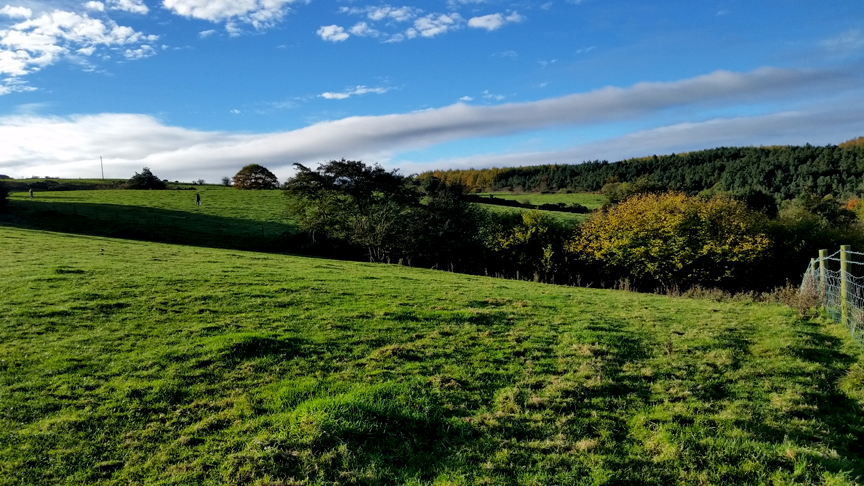
The first drive is normally in the 'Bottom Paddock' but since that housed two horses (which the farmer's son David offered to move) we started with the second drive, the 'Pit Yard'. Here, the nine Guns (seven shooting, two beating) lined up in a semi-circle in a field, on a bank beneath a wood. The Beaters start uphill, and beat down towards the Pit Yard itself.
I positioned myself at the bottom of the field just above the Pit Yard, about 30 yards behind Gun number 4, with my back to a sheep fence in the corner of the field. Pepper sat at my side, on a slack lead, watching intently. She had never seen anything like this, but she seemed to know that some fun was about to be had.
It wasn't long before pheasants started flushing and flying over the Guns. The gun reports were surprisingly loud but Pepper was unfazed. I've trained her using a 6mm blank pistol and .22LR blank dummy (bumper) launcher. She watched intently as the first birds sailed over, the high birds only being saluted by the Guns. She saw one cock bird shot cleanly overhead to our right by Gun 6 and she followed it as it curved to earth and landed with a thud in a gorse patch forty yards behind and to the side of us. But she didn't get up.
Gun 6's Labrador did though. She bolted from him and streaked out to the dead bird and retrieved it. She hadn't been sent for it, she was simply misbehaving. In fact, she picked the wrong bird because a second bird fell as she ran out and she grabbed that one.

There was a thick unkempt hawthorn hedge to our left, and a steep 20-foot earth bank beyond it. Pepper watched and heard several pheasant crashing down into the bank beyond the hedge, but she remained sitting. And then a large cock bird hit the ground with a loud thump not eight paces to my left, in plain view. I growled 'Leave it!' just in case Pepper was thinking of lunging for it, but bless her, she just gawped with her ears pricked even further forwards. The pheasant had his head up, indicating he was alive. He gave a few kicks and moved towards us a short distance, and then thrashed. Pepper stood up. Another 'Leave it, sit!' resulted in her sitting down and switching to overhead birds.
At the end of the drive, I made her stay while I picked the dead cock. I showed it to her and encouraged her to take hold, but she wouldn't. As I straightened, she jumped up to grab the pheasant by the head. I made her sit, opened her mouth and put the bird in. She refused to hold it. I didn't push the issue and hoped she might be better with a hen, being smaller.
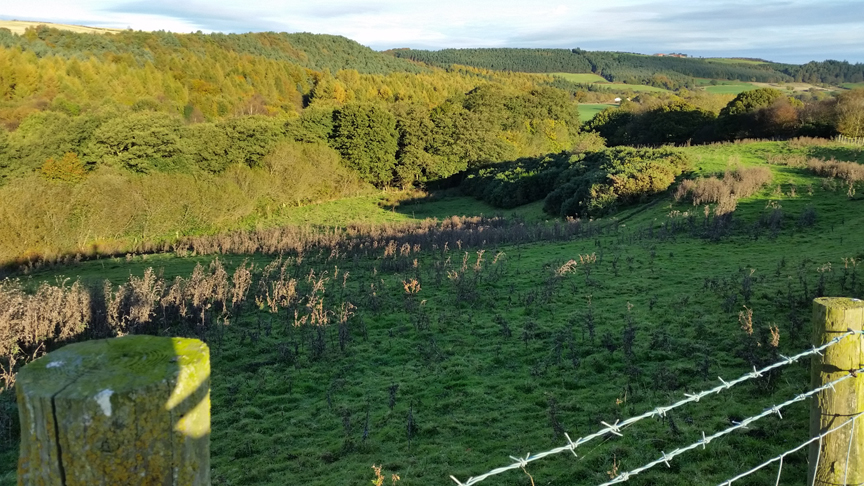
On the next drive, the Guns were lined up along a deep gully (drainage)—the trees are 60' tall—and a tributary gully full of undergrowth and cover for birds was beaten down. I was up at the top, in a field above the main gully, with David and his two dogs. David was there in case any pheasant decided not to follow the time-honoured route over the Guns; he was a flanking Gun.

Here is David with his two dogs, a Springer and a Labrador, and his Beretta 20 gauge (the only gun he ever uses). On this shoot you are often facing into the rising sun.
After the drive, I let Pepper off the lead and have a run with David's two dogs. After that, she was much more relaxed not just with them, but with all the other dogs of both sexes.
The next drive was 'Little Trees'. This is a very small plantation of fir trees, only about 15 yards wide and 100 yards long, adjacent to a farm track which 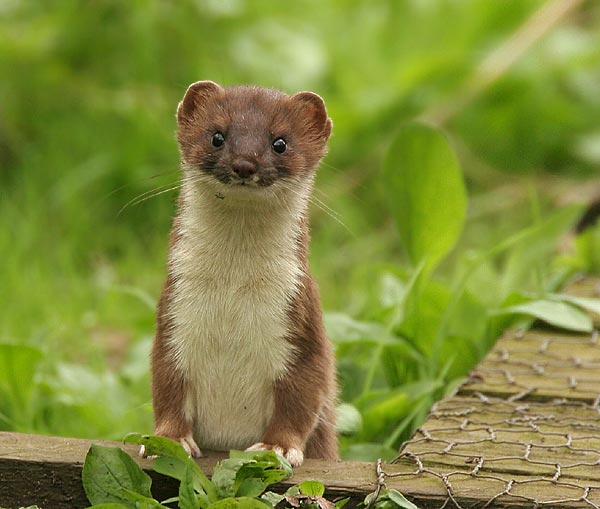 runs straight uphill. Surprisingly, Little Trees holds plenty of pheasant and when flushed, they head east for the cover of the large 'Middle Wood'. The Guns formed a line across the intervening field, beneath and east of Little Trees. I was placed in the field to the west of Little Trees, as a flanking beater with a flag. The flags are nothing elaborate: half a white plastic feed sack stapled onto a 4' length of 3/4 inch hazel.
runs straight uphill. Surprisingly, Little Trees holds plenty of pheasant and when flushed, they head east for the cover of the large 'Middle Wood'. The Guns formed a line across the intervening field, beneath and east of Little Trees. I was placed in the field to the west of Little Trees, as a flanking beater with a flag. The flags are nothing elaborate: half a white plastic feed sack stapled onto a 4' length of 3/4 inch hazel.
As we were waiting, Stephen's wife Jean pointed out a stoat (Mustela erminea, a member of the weasel family) that was busy hunting for its breakfast. The Spaniels worked their way downhill through Little Trees and flushed the best part of 30 birds. I couldn't see the Guns but I could hear them and see some falling birds. Pepper sat quietly at heel throughout. After the shot birds had been recovered, we regrouped.
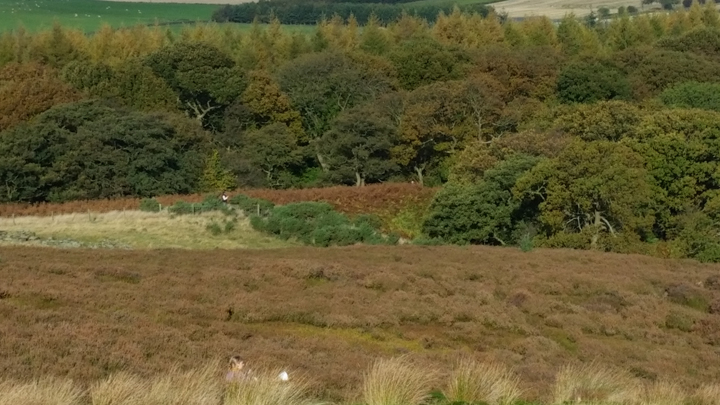
I was allocated to go up onto the moor with Hanna. She is the young wife of one of the Guns and a regular beater. A petite thing, she often gets the longest walks-out or the thickest of thickets to push through, yet she always come out smiling. She is a primary school teacher which may explain her endless patience and perseverance. In the picture above she's sitting in the foreground.
Our job was to climb up above the source of the main stream, go round the top end onto the far side (west) and act as flanking flag men. The Spaniels and some Labradors would work down within the drainage thus flushing the birds. Normally the birds fly down the drainage, gaining height as they head for some fir woods in the distance. Of course, the Guns are lined up in the deep drainage, where two streams join, and shoot the now high overhead birds. That's the theory. Our job was to wave our flags and 'turn' any pheasant that went the 'wrong' way.
 As we walked through the heather to get to our positions, the red grouse were cackling and flushing as singles. Pepper was very excited and I allowed her to run. The grouse—which had been shot walked-up style through mid-October—would not hold but kept flushing before Pepper could get a point. But it was obvious when she was working a particular bird. Instinct is a wonderful thing. On each flush, she was made to sit before being sent on. She was pretty good throughout, taking hand signals, working the scent well, sitting to flush. And she'd never seen it previously.
As we walked through the heather to get to our positions, the red grouse were cackling and flushing as singles. Pepper was very excited and I allowed her to run. The grouse—which had been shot walked-up style through mid-October—would not hold but kept flushing before Pepper could get a point. But it was obvious when she was working a particular bird. Instinct is a wonderful thing. On each flush, she was made to sit before being sent on. She was pretty good throughout, taking hand signals, working the scent well, sitting to flush. And she'd never seen it previously.
[Editor's Note: This is the same bird that in the USA is called the 'Willow Ptarmigan' (Lagopus lagopus); it's the official state bird of Alaska]
We got to our positions and Pepper sat at my side, on a slack lead once more. The drive in the gully started and the pheasant generally ran ahead of the dogs, reluctant to fly. Ultimately, each bird decided to take to its wings and most of them followed the plan. Many shots ensued and some of the birds folded up, but the majority escaped to the fir woods. In line with Hanna were two flanking guns; the rest of the Guns were down in the valley. The deciduous tree tops are 50 feet high in this location. The gully that was beaten is to the right edge of the photo. Beneath the blue sky is the North Sea and the tiny white 'sticks' (just barely seen in the centre of the photo) are power windmills. Hanna is standing in short heather, but the two flanking guns are invisible in this image.
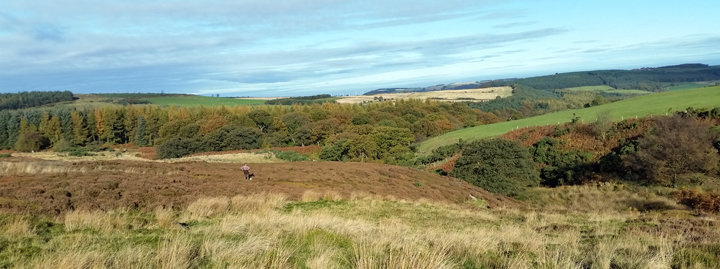
Once this drive was over, we all headed downhill, trudging up and across that green field seen on the right in the photo. We then followed the vehicle track to the farmyard for an early lunch. We sat on straw bales inside a barn to eat our assorted packed lunches. The appearance of a full grown rat in the barn had some of the ladies kicking up a faux fuss.

After lunch Four of us (plus dogs) got into a horse box and we were taken to the top of the hill, an S-bend called 'Birk Brow'. Our job was to line out across the moor directly above the farm itself, and beat down and across the more to a large coniferous wood, whose name I've forgotten (Middle Wood?). For the area we covered, we could have done with 15 beaters.
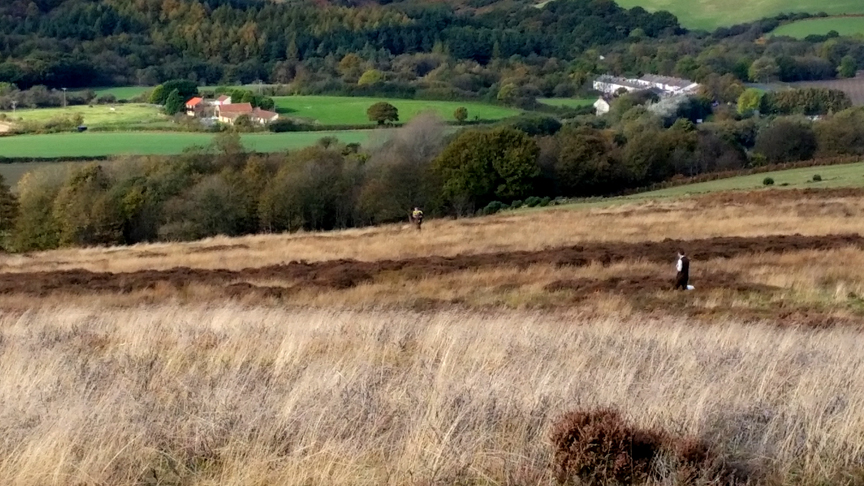
From the road, we walked the best part of 1/2 mile west along a narrow beaten footpath—actually a sheep track—and turning north towards the wood, and started beating. It was heather, which in places had been burned and was easy walking. Elsewhere, it varied from a foot high to waist high and was tough going for an unfit old fart like me. It was tough on Pepper too, working what little wind there was out in front, though she was enjoying it far too much to complain.
Once again, the ground was thick with red grouse, flushing in singles perhaps 25 yards in front of me. Pepper was getting to within a few yards of the birds, working the wind. I paused and took a few video clips of her working, this being her first day and all that. She was being pretty good, working the wind sensibly, taking hand signals, stopping on flush, but getting a little too excited at times. She wasn't quite sitting on flush; a bird would flush, she'd watch it go, then sit.
Other beaters were working their way up through Middle Wood, pushing the pheasant uphill. Co-ordination between the two groups of beaters was via PMR radio.
As we worked down and across the moor towards the top of Middle Wood, like the hand of a clock sweeping round, the ground cover changed a little. We started bumping and flushing pheasant.
There is a dry stone wall marking the boundary between moor and pasture. The Guns were lined up laterally along the hill in the pasture beneath us, a long way down: maybe 100 yards from the dry stone wall and to the right of Middle Wood. Pepper was getting a bit excited with the pheasants flushing: she had been fine with the grouse, the high heather helping to check her speed. I was just thinking about putting her on the lead when I looked behind me and saw her coursing a low-flying pheasant. I bellowed and she broke off and returned. That coincided with us reaching the wall and the end of the drive. I put her on the lead just in time to see a panicked rabbit run in front of us, through the wall, and along pretty much the entire line of Guns. Thanks to Stephen's prohibition on ground game, the rabbit made the 100 yard sprint to Middle Wood and safety.
Thereafter, a lot of us were hanging around at the wall while the Beaters who had worked through the wood joined us. We waited while Guns and other Beaters got in position for the final drive, so I let Pepper off the lead to mill around with the other dogs. A young woman (Zoe) whom I'd not met before, wearing riding jodhpurs and boots, arrived accompanied by two small Cockers, one a well grown pup. They jumped on Pepper; feeling insecure, she came to me for protection, and sat on my foot.
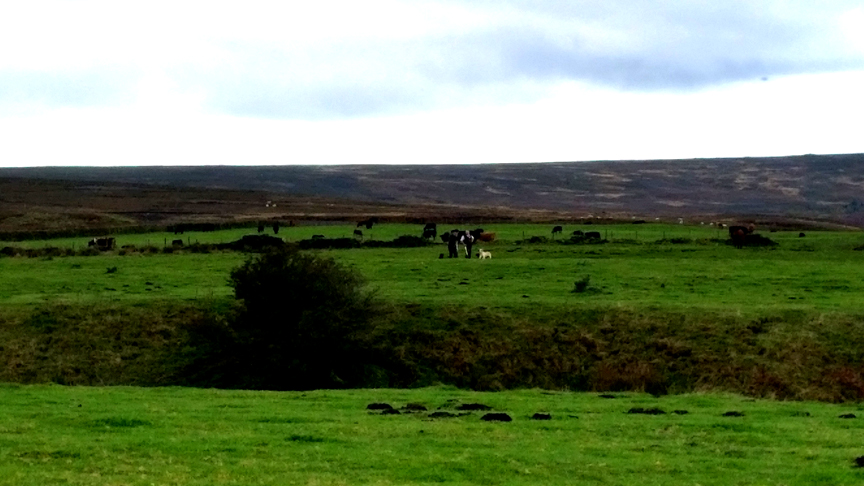
Eventually we all set off walking around the hill following the dry stone wall (not losing any height, thank goodness). Pretty much all of the dogs, including Pepper, were running loose. I thought it would help her to run with them. We'd gone maybe 200 yards, and I was looking down at some boggy ground trying not to go in too deep, when a sudden movement caught my attention. The two Cockers had flushed a hare and were coursing it. The hare was not running particularly quickly. Behind the Cockers was Pepper, in on the chase.
They were running in a semi-circle. I bellowed at Pepper. She broke off and came directly to me. I slipped the lead over her head and looked up: to everyone's surprise, the Cockers had got the hare! Since the dogs had had hold of the hare, it was decided to kill it. Steve (not to be confused with Stephen) did the necessary and tossed the dead hare aside. I said not to waste it, and Steve said 'You carry it if you want it'. I bagged the hare. It didn't weigh much, as it wasn't full grown. There was some discussion that the hare 'didn't look right' meaning it was sickly: 'How else could a couple of small Cockers have caught it?' I said I'd look at it later and if nothing else, it would be a training aid for the dogs.
The last drive was similar to the one we'd done before lunch: beat down some drainage with the Guns down in a larger drainage. But this time I was on the right hand side as flanking beater. I was at the top in a pasture field, which drops steeply and where the ground became a bit rough with reed beds, gorse patches etc. Pepper was running ahead of me and getting a bit slow at responding to my instructions: i.e., getting a bit headstrong. I was thinking it was time she went back on the lead for a cooling off period.
Just then we reached the 'Sudden steep bit' I'd been warned about. Pepper was at the bottom of a 30 foot bank. She abruptly came on point at the bottom of the bank, pointing a small reed patch (a clump about the size of a desk).
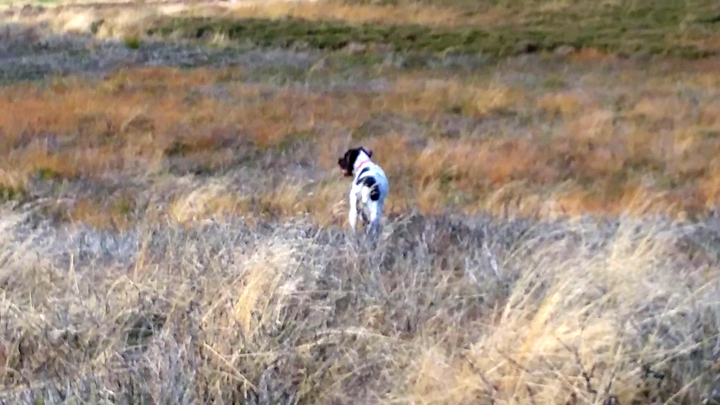
It was a good point: definite, firm, stylish. Just as I thought, 'Take a photo!' a full grown hare broke out of the reeds right in front of Pepper. This was only 20 minutes after the previous incident; she gave chase. The hare was in no hurry, loping round in a circle of maybe 10 yards. I bellowed thrice and Pepper broke off on the third call, coming directly up the hill to me. I bent down and took hold of her collar. Out of the corner of my left eye, I saw the hare had also come up the bank, stopping about five yards from me. Our eyes met and the hare took off up the hill like a scalded cat. And that was the end of the action: it was downhill to the farmyard.
All the game was gathered and counted, as were the spent cartridges. They always do this on this shoot: there is a little sweepstake at the start of the day on the number of cartridges fired. The nine guns had collectively fired 375 cartridges (seven guns were shooting on each drive). They had shot 47 pheasant, and 8 partridges (these are French or red-legged partridges, not Hungarians). And the dogs had killed one hare, but no one mentioned that.
Pepper learned a lot. It is worth noting that some of the regular dogs, including some that were professionally trained, behaved far worse than Pepper. So, although she chased two hares—and broke off—I'm pretty pleased overall with her performance.
Postscript: when I exercised the dogs this morning, I took a partridge with me. Pepper is most reluctant to hold it. I can't understand that. Most hunting dogs would be only too pleased to have a gamebird to hold.
| HUNTING | GUNS | DOGS |
| FISHING & BOATING | TRIP REPORTS | MISCELLANEOUS ESSAYS |
| CONTRIBUTIONS FROM OTHER WRITERS|
| RECIPES |POLITICS |

 And so the Birk Brow Shoot held their first day yesterday. I took my 18-month old GWP 'Pepper', not intending to work her but simply to let her see what the 'big dogs' get up to. In the event I was used as a spare beater and I did work her and she worked pretty well. She didn't do any retrieving and that was intentional.
And so the Birk Brow Shoot held their first day yesterday. I took my 18-month old GWP 'Pepper', not intending to work her but simply to let her see what the 'big dogs' get up to. In the event I was used as a spare beater and I did work her and she worked pretty well. She didn't do any retrieving and that was intentional. 




 runs straight uphill. Surprisingly, Little Trees holds plenty of pheasant and when flushed, they head east for the cover of the large 'Middle Wood'. The Guns formed a line across the intervening field, beneath and east of Little Trees. I was placed in the field to the west of Little Trees, as a flanking beater with a flag. The flags are nothing elaborate: half a white plastic feed sack stapled onto a 4' length of 3/4 inch hazel.
runs straight uphill. Surprisingly, Little Trees holds plenty of pheasant and when flushed, they head east for the cover of the large 'Middle Wood'. The Guns formed a line across the intervening field, beneath and east of Little Trees. I was placed in the field to the west of Little Trees, as a flanking beater with a flag. The flags are nothing elaborate: half a white plastic feed sack stapled onto a 4' length of 3/4 inch hazel.
 As we walked through the heather to get to our positions, the red grouse were cackling and flushing as singles. Pepper was very excited and I allowed her to run. The grouse—which had been shot walked-up style through mid-October—would not hold but kept flushing before Pepper could get a point. But it was obvious when she was working a particular bird. Instinct is a wonderful thing. On each flush, she was made to sit before being sent on. She was pretty good throughout, taking hand signals, working the scent well, sitting to flush. And she'd never seen it previously.
As we walked through the heather to get to our positions, the red grouse were cackling and flushing as singles. Pepper was very excited and I allowed her to run. The grouse—which had been shot walked-up style through mid-October—would not hold but kept flushing before Pepper could get a point. But it was obvious when she was working a particular bird. Instinct is a wonderful thing. On each flush, she was made to sit before being sent on. She was pretty good throughout, taking hand signals, working the scent well, sitting to flush. And she'd never seen it previously. 



